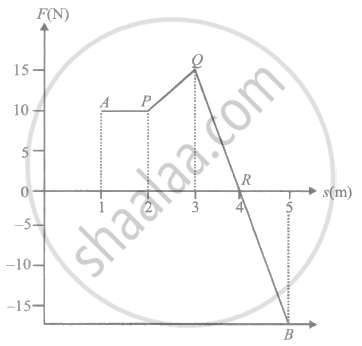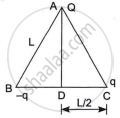Advertisements
Advertisements
प्रश्न
In a hydrogen atom, the electron and proton are bound at a distance of about 0.53 Å:
(a) Estimate the potential energy of the system in eV, taking the zero of the potential energy at infinite separation of the electron from proton.
(b) What is the minimum work required to free the electron, given that its kinetic energy in the orbit is half the magnitude of potential energy obtained in (a)?
(c) What are the answers to (a) and (b) above if the zero of potential energy is taken at 1.06 Å separation?
उत्तर
The distance between electron-proton of a hydrogen atom, d = 0.53 Å
Charge on an electron, q1 = −1.6 × 10−19 C
Charge on a proton, q2 = +1.6 × 10−19 C
(a) Potential at infinity is zero.
Potential energy of the system, = Potential energy at infinity − Potential energy at distance d
= `0 - ("q"_1"q"_2)/(4piin_0"d")`
where,
∈0 is the permittivity of free space
`1/(4piin_0) = 9 xx 10^9 "Nm"^2 "C"^-2`
∴ Potetial energy = `0 - (9 xx 10^9 xx (1.6 xx 10^-19)^2)/(0.53 xx 10^10)`
= `-43.47 xx 10^-19 "J"`
Since `1.6 xx 10^-19 "J" = 1 "eV"`
∴ Potetial energy = `-43.7 xx 10^-19 =(-43.7 xx 10^-19)/(1.6 xx 10^-19) = -27.2 "eV"`
Therefore, the potential energy of the system is −27.2 eV.
(b) Kinetic energy is half of the magnitude of potential energy.
Kinetic energy = `1/2 xx (-27.2)` = 13.6 eV
Total energy = 13.6 − 27.2 = 13.6 eV
Therefore, the minimum work required to free the electron is 13.6 eV.
(c) When zero of potential energy is taken, `"d"_1` = 1.06 Å
∴ Potential energy of the system = Potential energy at d1 − Potential energy at d
= `("q"_1"q"_2)/(4piin_0"d"_1)-27.2 "eV"`
= `(9 xx 10^9 xx (1.6 xx 10^-19)^2)/(1.06 xx 10^-10)-27.2 "eV"`
= `21.73 xx 10^-19 "J" - 27.2 "eV"`
= 13.58 eV − 27.2 eV
= −13.6 eV
APPEARS IN
संबंधित प्रश्न
A small test charge is released at rest at a point in an electrostatic field configuration. Will it travel along the field line passing through that point?
What is the work done by the field of a nucleus in a complete circular orbit of the electron? What if the orbit is elliptical?
We know that electric field is discontinuous across the surface of a charged conductor. Is electric potential also discontinuous there?
Guess a possible reason why water has a much greater dielectric constant (= 80) than say, mica (= 6).
Obtain an expression for an intensity of electric field at a point at the end of position, i.e., the axial position of an electric dipole.
x
Three point charges +q each are kept at the vertices of an equilateral triangle of side 'l'. Determine the magnitude and sign of the charge to be kept at its centroid so that the charges at the vertices remain in equilibrium.
Why must electrostatic field be normal to the surface at every point of a charged conductor?
A body moves from point A to B under the action of a force, varying in magnitude as shown in the figure. Force is expressed in newton and displacement in meter. What is the total work done?

Two point charges placed in a medium of dielectric constant 5 are at a distance r between them, experience an electrostatic force 'F'. The electrostatic force between them in vacuum at the same distance r will be-
If stretch in a spring of force constant k is tripled then the ratio of elastic potential energy in the two cases will be:
A work of 100 joule is performed in carrying a charge of 5 coulomb form infinity to a particular. point in an' electrostatic field. The potential of this point is:-
In bringing one electron towards another electrons, the electrostatic potential energy of the system will.
In a region of constant potential ______.
- the electric field is uniform
- the electric field is zero
- there can be no charge inside the region
- the electric field shall necessarily change if a charge is placed outside the region
A point charge q0 is moving along a circular path of radius a, with a point charge Q at the centre of the circle. The kinetic energy of q0 is ______.
Three-point charges Q, q and -q are kept at the vertices of an equilateral triangle of side L as shown in the figure. What is

- the electrostatic potential energy of the arrangement? and
- the potential at point D?
